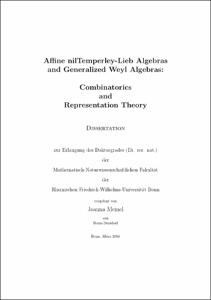Affine nilTemperley-Lieb Algebras and Generalized Weyl AlgebrasCombinatorics and Representation Theory

Affine nilTemperley-Lieb Algebras and Generalized Weyl Algebras
Combinatorics and Representation Theory

| dc.contributor.advisor | Stroppel, Catharina | |
| dc.contributor.author | Meinel, Joanna | |
| dc.date.accessioned | 2020-04-22T21:36:42Z | |
| dc.date.available | 2020-04-22T21:36:42Z | |
| dc.date.issued | 13.09.2016 | |
| dc.identifier.uri | https://hdl.handle.net/20.500.11811/6866 | |
| dc.description.abstract | This thesis lies at the crossroads of representation theory and combinatorics. It is subdivided into two parts, each of which is devoted to a particular combinatorial technique in the study of weight modules. In the first part, we start out by a short review of crystal bases for finite-dimensional simple modules of the quantum group Uq(sln(C)) and for Kirillov-Reshetikhin modules of the quantum affine algebra. We identify crystal bases with combinatorially defined particle configurations on a lattice. Such particle configurations consist of a finite number of particles distributed along a line segment (the finite/classical case) or along a circle (the affine case). There are two versions present: Fermionic configurations where only one particle is allowed at each position, and bosonic configurations where arbitrarily many particles are admissible. Under this identification, Kashiwara crystal operators correspond to particle propagation operators, pushing particles from one position in the lattice to another. These operators satisfy the plactic relations, and we want to describe the algebras that act faithfully on the particle configurations. It is known that the nilTemperley-Lieb algebra acts faithfully on fermionic particle configurations on a line segment. For bosonic particle configurations on line segments, we prove faithfulness of the action of the so-called partic algebra, which we define as a quotient of the plactic algebra. We construct a basis of the partic algebra, and we describe its center. The question becomes substantially harder in the affine case. For fermionic particle configurations on a circle it is the affine nilTemperley-Lieb algebra that acts faithfully. This is an infinite dimensional algebra defined by generators and relations. Our main results for the affine nilTemperley-Lieb algebras include different bases of the algebra, an explicit description of its center, and a classification of its simple modules. Furthermore, we define embeddings of the affine nilTemperley-Lieb algebra on N generators into the affine nilTemperley-Lieb algebra on N+1 generators. For bosonic particle configurations on a circle we find an interesting family of additional relations that are not obvious from the classical case. The second part of the thesis exhibits a different combinatorial approach to weight modules, namely that of discrete geometry applied to the support of a module. This time we consider the representation theory of generalized Weyl algebras, a class of algebras that generalizes the definition of the Weyl algebra, the algebra of differential operators on a polynomial ring. Its weight modules allow a beautiful description in terms of lattice points and hyperplanes. We apply a theorem by Musson and Van den Bergh to a special class of generalized Weyl algebras, thereby proving a Duflo type theorem stating that the annihilator of any simple module is in fact given by the annihilator of a simple highest weight module. | en |
| dc.language.iso | eng | |
| dc.rights | In Copyright | |
| dc.rights.uri | http://rightsstatements.org/vocab/InC/1.0/ | |
| dc.subject | Höchstgewichtsmodule | |
| dc.subject | Gewichtsgitter | |
| dc.subject | Duflotheorem | |
| dc.subject | Zentrum | |
| dc.subject | zentraler Charakter | |
| dc.subject | plaktische Algebra | |
| dc.subject | Kristalle | |
| dc.subject | einfache Module | |
| dc.subject | Normalform | |
| dc.subject | Basis | |
| dc.subject | Teilchenkonfiguration | |
| dc.subject | highest weight modules | |
| dc.subject | weight lattice | |
| dc.subject | Duflo theorem | |
| dc.subject | center | |
| dc.subject | central character | |
| dc.subject | plactic algebra | |
| dc.subject | crystals | |
| dc.subject | simple modules | |
| dc.subject | normal form | |
| dc.subject | particle configuration | |
| dc.subject.ddc | 510 Mathematik | |
| dc.title | Affine nilTemperley-Lieb Algebras and Generalized Weyl Algebras | |
| dc.title.alternative | Combinatorics and Representation Theory | |
| dc.type | Dissertation oder Habilitation | |
| dc.publisher.name | Universitäts- und Landesbibliothek Bonn | |
| dc.publisher.location | Bonn | |
| dc.rights.accessRights | openAccess | |
| dc.identifier.urn | https://nbn-resolving.org/urn:nbn:de:hbz:5n-44522 | |
| ulbbn.pubtype | Erstveröffentlichung | |
| ulbbnediss.affiliation.name | Rheinische Friedrich-Wilhelms-Universität Bonn | |
| ulbbnediss.affiliation.location | Bonn | |
| ulbbnediss.thesis.level | Dissertation | |
| ulbbnediss.dissID | 4452 | |
| ulbbnediss.date.accepted | 29.07.2016 | |
| ulbbnediss.institute | Mathematisch-Naturwissenschaftliche Fakultät : Fachgruppe Mathematik / Mathematisches Institut | |
| ulbbnediss.fakultaet | Mathematisch-Naturwissenschaftliche Fakultät | |
| dc.contributor.coReferee | Haahr Andersen, Henning |
Files in this item
This item appears in the following Collection(s)
-
E-Dissertationen (4442)




